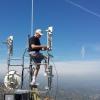Asking for a friend who's become a bit soured on mesh networking, at least in his situation.
"All Ethernet cables are shielded, HF coax and Ethernet cables are separated from each other, ferrites (multiple) on ethernet cables (power cables and in every imaginable place). No cigar. I am coming to conclusion that this particular hardware is useless in ham environment where high power HF is used (& antennas are very close)"
Any ideas?
Thanks.
"All Ethernet cables are shielded, HF coax and Ethernet cables are separated from each other, ferrites (multiple) on ethernet cables (power cables and in every imaginable place). No cigar. I am coming to conclusion that this particular hardware is useless in ham environment where high power HF is used (& antennas are very close)"
Any ideas?
Thanks.


Granted that’s not considered high power but never seen a problem.
My switch and power supplies for the mesh stuff is all right next to the IC-746 as well. Sounds like your friend is probably seeing high return ground currents into the shack?
Hi,
Happens = dead (both wired and wireless). Only turning off the power & then back on will get it back.
Sorry, I did not have account on aredn and hoped that the answer would be simple and asked Orv to relay.
Jussi (AA6KJ)
Sounds like your friend has an issue with RF in the shack, and most likely it is affecting other devices too, and possibly his neighbor's. I would suggest start with replacing that G5RV with resonant dipoles for 40 and 80m.
Had a problem with optical mouse in the shack, which was cured by a ferrite. No other interference issues at our place (or neighbors) - except on 15 m when I turn my beam towards neighbors OTA TV antenna (their antenna pre amp goes into gain compression; this is a separate issue). The curious thing is that this nanostation issue happens only on 80/40m - but then my 20 - 10m beam set up is father away from the nanostation. All I can think of is to somehow increase the separation between the HF antenna and the nanostation - not trivial on these stamp sized lots :-(
Jussi
Is the Cat5 shielded?
cat5 is shielded. How do I shield the nanobridge? It is getting ground through the ethernet cable (metal plated connectors at ends).
Jussi
As noted these devices have been installed on AM/FM radio towers, but this could be a frequency dependent failure if we are hitting an oscillator inside.
First off there is a note for using shielded cable, I would actually up this to make sure your using double shielded cable since we are talking so high power here. Double Shielded has both an aluminum shield and a braided high current shield. However there is also an exception to this that it might also be better to run fiberoptics up to the node and convert at the hardware to Shielded Twisted Pair (STP) wire if the cause is because of induction on the network cable. This has been done on some FM tower installs because of issues.
Ferrites: Depending where you put them I would wonder if they are not actually adding to the the problem, the Ubiqutii hardware relies on the shield as part of the drain path to pull EMI away from the device, if you choke the cables at the ground side you may be forcing it back into the hardware. On top of that if you are a lightning arrestor for the network cable make sure it ties the shield to ground either at the arrestor or down stream at a good ground point on the shielded cable (many arrestors I've used especially from L-COM actually float the ground and rely on the output port to ground it unless there is a lightning strike where it arcs over the gas tube, while this is good if you have a solid ground at the computer or power injector end of the cable, if not it basically negates the shield drain purpose)
https://www.rfarmor.com/unbk5.html (previous link was a nanostation) of course this will do little good if the direction you point the node is directly into the antenna but if the antenna is to the side or even better behind the node this can add some significant isolating keeping the RF power from getting in via the plastic case.
If that doesn't work I know some support for the Rocket Titanium is working its way through code review , it may be the better option (the Rocket Titanium is enclosed in a metal enclosure) once it hits. 1500w at 20feet is roughly 500v P-P (assuming unity gain on both sides) being thrown at the Ubiquity hardware. I don't know many ham radio operators who would put their TV that close to the antenna, the same is true for AREDN gear without shielding, its a complicated device.
I'll admit there isn't much data on HAM frequencies being used near these devices, the oscillators would be my main concern of being overloaded and locking the device up for you.